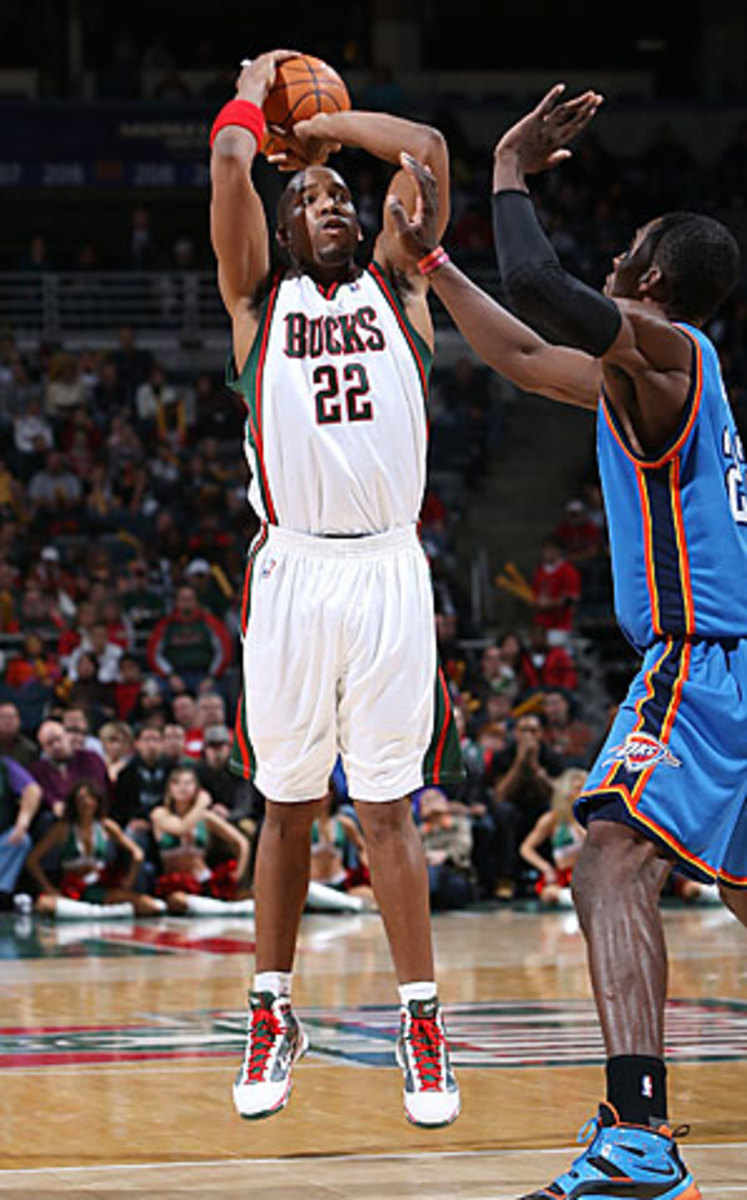
Redd not ready to call it quits
BOSTON -- Michael Redd could have quit. He could have walked away from the game and no one would have thought less of him. As he lay prone on the Staples Center floor last January, the ACL and MCL in his left knee shredded for the second time in less than a year, Redd had few reasons to pick himself back up. He had earned more than $100 million in his career. He had made an All-Star team and won an Olympic gold medal. By anyone's measure, Redd's career had been a success.
But he didn't quit. He got up (again), had surgery (again) and put his body through a sometimes-painful, often-grueling rehab (again). For 2½ hours a day, five days a week, Redd, 31, worked with trainers at the Ohio State Medical Center, pounding his legs with squats and exploding drills and running his body ragged.
Today, the hard work has paid off. Working out before Milwaukee's game against the Celtics on Sunday, Redd moved fluidly, cutting and pivoting without any hesitation. His 6-foot-6 frame looked solid -- he weighs a career-low 214 pounds -- and the polished jump shot that made him one of the most dangerous shooters in the game appeared sharp.
"I just wasn't going to go out like that," Redd said. "It's not about money. It's about ending my career on my terms. I don't want to end my career limping off the floor. That motivated me, it pushed me through the physical therapy, the training, everything."
Indeed, when the doctors told him he needed another surgery, Redd had just one question: If I do this, he asked, can I get back to being the player I was?
"They said, 'Absolutely,' " Redd said. "They told me, 'Do the rehab and the therapy right, you can come back better than ever.' Because I'll be honest, I had doubts if I would be able to come back and play at the level I'm used to playing at."
And the Bucks could use the help. Shooting has been a particular problem for Milwaukee this season. The team's field-goal percentage has dipped from 43.6 last season to a league-worst 42.5 this year. Wins and losses are often tied directly to shooting percentage and Milwaukee is no different: The Bucks are 17-5 when they shoot 45 percent or better and 9-35 when they don't.
An often-asked question is what role Redd will play when he comes back. He has played in just 51 games over the last three seasons and will likely be under a minutes restriction when he returns. With the Bucks in the thick of the race for the East's last playoff spot -- through Tuesday they were 2½ games behind Indiana -- it makes working him back into the rotation problematic.
"Part of the issue is we haven't been able to get him in much four-on-four, five-on-five up-and-down [drills] yet," coach Scott Skiles said. "We just haven't had time to do it. So we'd like to get a couple of those in. What I've tried to do is not predetermine [Redd's minutes]; just see where we're at right at that moment. If we're a game ahead [in the playoffs] or two games ahead, I don't know if that's time to experiment. On the other hand, he looks good."
Redd says he is fine with whatever role Skiles gives him. He says his knee has tested "through the roof" and is ready to go. He is hoping to return either Sunday or Wednesday of next week and says he is just anxious to get back on the court.
"I'm just going to go do my thing," Redd said. "The minutes are up to the coaches. Last time, I came back a little too quickly. I think the key for me now is trying to get a rhythm. I have high expectations for myself, but I know it's important to get into a rhythm. I just have to chip at it and try to contribute."
Redd admits part of the reason he is coming back is to show the rest of the league he can still play. He is in the final year of a six-year, $91 million contract and understands no team is going to commit to a thirtysomething shooting guard with a bum knee unless he proves that knee is healthy.
"The No. 1 reason for playing is to help this team into the playoffs," Redd said. "But I want to let the league know I'm back and am still that threat out there."
Redd is aware his future likely will be somewhere other than Milwaukee. The Bucks signed John Salmons to a five-year, $39 million deal last summer and traded for swingmen Corey Maggette and Chris Douglas-Roberts. His position is fully stocked. But there is no shortage of teams that could use an accomplished scorer and a career 38.5 percent three-point shooter.
"I want to win," Redd said.
His future, Redd says, is something he will worry about this summer. For now, it's all about getting back on the floor, about erasing the painful memory of that night in Los Angeles and starting a new chapter in his career. And all indications are that Redd is poised to make that chapter a long one.
"To me, he looks better than he did the first time he [had surgery] and came back," Skiles said. "Anyone that has tried to rehab at all knows how tedious that process is, and he has gone through it twice for long periods of time. We won't know for sure until he gets some live work, but he certainly looks like he's in shape and ready to go."





